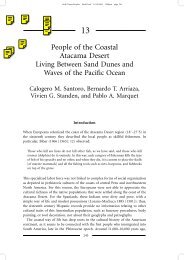Geographical distribution of Tillandsia lomas in the Atacama ... - IEB
Geographical distribution of Tillandsia lomas in the Atacama ... - IEB
Geographical distribution of Tillandsia lomas in the Atacama ... - IEB
Create successful ePaper yourself
Turn your PDF publications into a flip-book with our unique Google optimized e-Paper software.
544ARTICLE IN PRESSR. P<strong>in</strong>to et al. / Journal <strong>of</strong> Arid Environments 65 (2006) 543–552desert is cont<strong>in</strong>uous from Peru to Chile, it is usually broken down <strong>in</strong>to two ma<strong>in</strong>components, <strong>the</strong> Peruvian Coastal Desert from <strong>the</strong> area <strong>of</strong> Tumbes (ca. 51S) to Tacna (ca.181S), and <strong>the</strong> <strong>Atacama</strong> Desert from <strong>the</strong> area <strong>of</strong> Arica <strong>in</strong> nor<strong>the</strong>rn Chile (ca. 18120 0 S) toCopiapo (ca. 271S) (for a general description <strong>of</strong> <strong>the</strong> <strong>Atacama</strong> Desert area see also Rauh,1985a; Arroyo et al., 1988; Rundel et al., 1991; Marquet, 1994; Marquet et al., 1998;Latorre et al., 2002).Fog is <strong>the</strong> most important source <strong>of</strong> humidity <strong>in</strong> <strong>the</strong> <strong>Atacama</strong> Desert. Fog owes itexistence to <strong>the</strong> regular formation <strong>of</strong> thick stratocumulus cloud banks below 1000 m,which, when <strong>in</strong>tercepted by isolated mounta<strong>in</strong>s or steep coastal slopes <strong>of</strong> <strong>the</strong> Coastalcordillera give rise to a fog zone known as garúa <strong>in</strong> Peru and camanchaca <strong>in</strong> Chile. The<strong>in</strong>creased moisture <strong>in</strong> <strong>the</strong> fog zone allows for <strong>the</strong> development <strong>of</strong> isolated and diversevegetation formations called <strong>lomas</strong> (small hills), which also develop <strong>in</strong>land across lowaltitude areas <strong>of</strong> <strong>the</strong> Coastal cordillera that allow for <strong>the</strong> <strong>in</strong>land penetration <strong>of</strong> fog (Abele,1981) creat<strong>in</strong>g a corridor <strong>of</strong> <strong>in</strong>creased humidity and <strong>lomas</strong> formations (P<strong>in</strong>to, 1999;Mun˜oz-Schick et al., 2001; P<strong>in</strong>to, 2001).<strong>Tillandsia</strong> or ‘‘airplants’’ are <strong>the</strong> qu<strong>in</strong>tessential <strong>in</strong>habitants <strong>of</strong> <strong>lomas</strong> formations. Fifteen<strong>Tillandsia</strong> species have been quoted for coastal Peru and nor<strong>the</strong>rn Chile (Dillon, 1991;Brako and Zarucchi, 1993; Rundel et al., 1997; Rundel and Dillon, 1998). The mostnoticeable species are <strong>the</strong> ones that have <strong>in</strong>vaded sandy soils, cover<strong>in</strong>g vast areas andform<strong>in</strong>g specialized communities called ‘‘tillandsiales’’. Their <strong>distribution</strong> has been wellstudied <strong>in</strong> Peru (Oka and Ogawa, 1984), where is known that <strong>the</strong>y are located <strong>in</strong> patchesfrom Trujillo (81S) to Tacna (181S). Eight sandy species form tillandsiales <strong>in</strong> Peru:T. capillaris, T. landbeckii, T. latifolia, T. marconae, T. paleacea, T. purpurea, T. recurvataand T. werdermannii. In <strong>the</strong>se usually monospecific communities, plants form parallelbands perpendicular to fog penetration or round mounds (Fukushima, 1969). In nor<strong>the</strong>rnand central Peru, <strong>Tillandsia</strong> <strong>lomas</strong> occur at high densities both near <strong>the</strong> ocean and <strong>in</strong> <strong>in</strong>landlocations (Rundel and Dillon, 1998). In central Peru, <strong>the</strong>y are located between 600 and700 m <strong>of</strong> altitude and <strong>the</strong>ir altitud<strong>in</strong>al range <strong>in</strong>creases southwards reach<strong>in</strong>g between 750and 1100 m <strong>in</strong> sou<strong>the</strong>rn Peru, and between 900 and 1300 m <strong>in</strong> nor<strong>the</strong>rn Chile (Oka andOgawa, 1984; Ono, 1986).Knowledge <strong>of</strong> <strong>Tillandsia</strong> species <strong>in</strong> Chile is limited and fragmentary (Rauh, 1985b; Zizkaand Mun˜oz-Schick, 1993). Accord<strong>in</strong>g to Rauh (1985a), <strong>the</strong> sou<strong>the</strong>rn limits <strong>of</strong> <strong>Tillandsia</strong><strong>lomas</strong> are located near Iquique. Similarly, Rundel et al. (1997), probably <strong>the</strong> mostcomprehensive study <strong>of</strong> <strong>Tillandsia</strong> <strong>lomas</strong> <strong>in</strong> Chile, <strong>in</strong>dicate that <strong>the</strong>y are rare <strong>in</strong> Chile andlocalized ma<strong>in</strong>ly to <strong>the</strong> West <strong>of</strong> Iquique. However, <strong>the</strong>se studies (see also Cereceda et al.,1999) have been restricted <strong>in</strong> spatial extent. In this paper we characterize <strong>the</strong> geographic<strong>distribution</strong> <strong>of</strong> <strong>Tillandsia</strong> <strong>lomas</strong> <strong>in</strong> nor<strong>the</strong>rn Chile, as well as <strong>the</strong>ir floristic composition andspatial extent <strong>of</strong> each community. We show that <strong>Tillandsia</strong> <strong>lomas</strong> are not rare <strong>in</strong> <strong>the</strong> regionand follow a dist<strong>in</strong>ct pattern <strong>of</strong> <strong>distribution</strong> associated to <strong>the</strong> existence <strong>of</strong> major fogcorridors along <strong>the</strong> costal area.2. Materials and methods2.1. Study areaThe costal zone <strong>of</strong> <strong>the</strong> <strong>Atacama</strong> Desert <strong>in</strong> nor<strong>the</strong>rn Chile has a remarkablehomogeneous temperature (18 1C). The average annual precipitation at Iquique has been
















